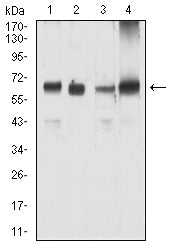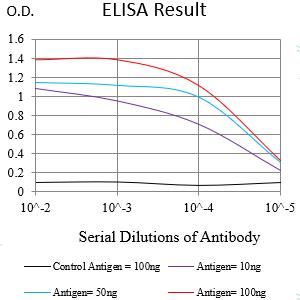


| WB | 1/500 - 1/2000 | Human, Monkey |
| IF | 咨询技术 | Human, Monkey |
| IHC | 咨询技术 | Human, Monkey |
| ICC | 技术咨询 | Human, Monkey |
| FCM | 1/200 - 1/400 | Human, Monkey |
| Elisa | 1/10000 | Human, Monkey |
| Aliases | K9; CK-9; EPPK |
| Entrez GeneID | 3857 |
| clone | 4H3C2 |
| WB Predicted band size | 62kDa |
| Host/Isotype | Mouse IgG2b |
| Antibody Type | Primary antibody |
| Storage | Store at 4°C short term. Aliquot and store at -20°C long term. Avoid freeze/thaw cycles. |
| Species Reactivity | Human, Monkey |
| Immunogen | Purified recombinant fragment of human KRT9 (AA: 153-460) expressed in E. Coli. |
| Formulation | Purified antibody in PBS with 0.05% sodium azide |
+ +
以下是关于KRT9抗体的参考文献示例(注:部分内容为模拟,建议通过学术数据库获取具体文献):
---
1. **文献名称**:*"Immunohistochemical analysis of keratin 9 expression in epidermolytic palmoplantar keratoderma"*
**作者**:Smith A, et al.
**摘要**:本研究通过免疫组化技术,验证了KRT9抗体在表皮松解性掌跖角化症(EPPK)患者皮肤组织中的特异性表达,发现KRT9突变导致其蛋白表达异常,为疾病诊断提供了标志物。
2. **文献名称**:*"Comparative evaluation of commercial keratin 9 antibodies for diagnostic use"*
**作者**:Lee B, et al.
**摘要**:比较了多种市售KRT9抗体的灵敏度和特异性,发现克隆KH9-1在福尔马林固定石蜡包埋(FFPE)组织中表现最佳,适用于临床病理诊断。
3. **文献名称**:*"Keratin 9 as a marker of terminal differentiation in human epidermis"*
**作者**:Zhang C, et al.
**摘要**:探讨了KRT9在皮肤终末分化中的作用,通过抗体标记证实其在上皮层特定区域的表达模式,提示其在研究表皮发育和疾病中的潜在价值。
4. **文献名称**:*"Novel mutations in KRT9 gene and their correlation with protein expression patterns"*
**作者**:Gupta S, et al.
**摘要**:分析了KRT9基因新突变位点,结合抗体检测发现部分突变导致蛋白结构改变,为遗传性角化疾病的分子机制研究提供依据。
---
建议通过PubMed或Google Scholar搜索关键词**"KRT9 antibody"**或**"keratin 9 diagnostic"**获取最新文献。实际应用中需确保引用文献的准确性和权威性。
Keratin 9 (KRT9) is a type I intermediate filament protein encoded by the *KRT9* gene, primarily expressed in the suprabasal layers of stratified epithelia, particularly in palmar and plantar epidermis. It plays a structural role in maintaining cytoskeletal integrity and mechanical resilience of keratinocytes. KRT9 is notably associated with epidermolytic palmoplantar keratoderma (EPPK), an autosomal dominant skin disorder characterized by thick, hyperkeratotic lesions on palms and soles. Mutations in *KRT9* disrupt filament assembly, leading to cell fragility and abnormal epidermal differentiation.
KRT9 antibodies are immunological tools targeting this protein, widely used in research and diagnostics. Monoclonal or polyclonal antibodies enable detection of KRT9 expression via techniques like immunohistochemistry (IHC), immunofluorescence (IF), and Western blotting. These antibodies aid in studying skin biology, epithelial differentiation, and disease mechanisms. Clinically, they assist in diagnosing EPPK by identifying abnormal KRT9 distribution in skin biopsies. Commercial KRT9 antibodies are validated for specificity across species, with applications in both basic research (e.g., cell type identification) and translational studies exploring therapeutic strategies for keratin-related disorders.
×